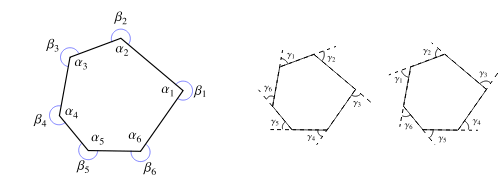An Introduction to Alternate Exterior Angles in Geometry

Alternate exterior angles are a type of angle found when two lines are crossed by a third line, known as a transversal. These angles can be found on either side of the transversal and outside the two lines that are crossed. Alternate exterior angles are important in geometry, as they can be used to form and identify congruent angles.
Definition of Alternate Exterior Angles
Alternate exterior angles, also known as "consecutive exterior angles," are two angles that are located on opposite sides of a transversal line and outside the two lines crossed by the transversal line. These angles are supplementary, meaning that they add up to 180 degrees. They are also congruent, meaning that they are equal in measure. The two alternate exterior angles are always congruent to each other, regardless of the type of lines that are crossed.
Identifying Alternate Exterior Angles
To identify alternate exterior angles, you need to first identify the transversal line. This line crosses through two other lines, which are usually parallel lines. Once the transversal line is identified, look for the two angles that are located on opposite sides of the transversal line and outside of the two lines crossed by the transversal line. These are the alternate exterior angles.
Theorem of Alternate Exterior Angles
The theorem of alternate exterior angles states that when two parallel lines are crossed by a transversal line, the alternate exterior angles are congruent. This means that the two angles have the same measure. This theorem can be used to prove the existence of parallel lines. It can also be used to prove that two angles are congruent.
Examples of Alternate Exterior Angles
To understand alternate exterior angles better, here are some examples of how to identify them. In the figure below, the two lines AB and CD are crossed by the transversal line EF. The angles 1 and 2 are alternate exterior angles. The angles 3 and 4 are also alternate exterior angles.

Practice Problems
Here are some practice problems to help you test your understanding of alternate exterior angles.
- Identify the alternate exterior angles in the figure below.

The angles 1 and 2 are alternate exterior angles.
- Are angles 3 and 4 alternate exterior angles in the figure shown above?
No, angles 3 and 4 are not alternate exterior angles in the figure shown above.
- Are angles 5 and 6 alternate exterior angles in the figure shown above?
Yes, angles 5 and 6 are alternate exterior angles in the figure shown above.
- Are the alternate exterior angles in the figure below congruent?

Yes, the alternate exterior angles in the figure above are congruent.
- What is the measure of the alternate exterior angles in the figure above?
The measure of the alternate exterior angles in the figure above is 45 degrees.
- Are the alternate exterior angles in the figure below supplementary?

Yes, the alternate exterior angles in the figure above are supplementary.
- What is the sum of the measure of the alternate exterior angles in the figure above?
The sum of the measure of the alternate exterior angles in the figure above is 180 degrees.
Conclusion
In conclusion, alternate exterior angles are angles found on opposite sides of a transversal line and outside the two lines crossed by the transversal line. These angles are congruent and supplementary, and they can be used to form and identify congruent angles. By understanding how to identify alternate exterior angles, you can use this knowledge to solve many geometry problems.
FAQ
What is an alternate exterior angle?
An alternate exterior angle is an angle outside two lines that are cut by a transversal, and are on opposite sides of the transversal.
How are alternate exterior angles related to each other?
Alternate exterior angles are always equal to each other.